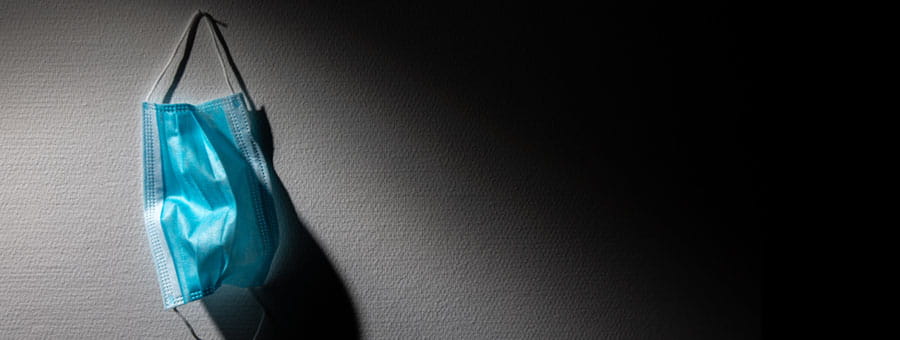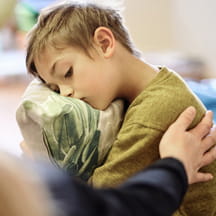In March 2020, the COVID-19 pandemic was raging across the country. Cities were quickly shutting down, urging residents to stay home. Medical facilities, including children’s hospitals, hit pause on elective procedures and leaned into telehealth to care for patients. But children’s hospitals were met with a confusing crisis.
COVID-19 was affecting fewer pediatric patients compared to the adult population, yet children’s hospitals were faced with revenue shortfalls, staffing changes, new policies and procedures, preparations for taking in adult patients, and general fear of the unknown. The censuses may have been down, but COVID-19 was felt in every corner of children’s hospitals. Leaders feared a looming mental health crisis for their teams and faced new challenges in meeting their needs.
While burnout in health care workers is not new, children’s hospitals are now seeing it through the lens of a public health crisis. The pandemic necessitates new solutions with added urgency to a long-standing issue, as children’s hospitals are not only rethinking how they provide care to patients, but also their employees.
“There’s more of a sense of urgency now,” says Jennifer Bickel, M.D., medical director, Professional Well-being at Children’s Mercy Kansas City in Missouri. “Every domain of people’s lives has changed. Add in a personal safety concern like people have never had before, job insecurity for themselves or a family member, financial stress, and we’re talking about a much more fragile workforce.”
Constantly changing gears
Professionally and personally, health care workers have experienced a shift. New blurred lines exist between work and home for remote workers and those still at the bedside who are worried about bringing the virus home.
“The strain associated with the pivoting we had to do, the problem solving we had to do in rapid succession and the personal worries about the future, it is exhausting in ways we could not have possibly been prepared for,” says Allison Scobie-Carroll, M.S.W., LICSW, MBA, senior director, Social Work and Family Services at Boston Children’s Hospital.
One of the challenges at the beginning of the pandemic was managing the flow of information, everything from national and local guidelines to virus transmission and operational protocols. Bickel frames it as decision fatigue, where hospital staff were constantly making decisions in rapidly changing and uncertain environments.
Rob McGregor, M.D., chief medical officer at Akron Children’s Hospital, sees the underlying issue as a lack of a single source of truth. He says the only thing providers knew about the virus was they didn’t know everything about the virus.
It required all hospital staff to change how they reference and keep up with ever-changing information. “Doctors often resorted to printing the latest guidance, and that became gospel,” McGregor says. “Morale was really struck by the fact that at 2 p.m., we were getting one message, and by 6 p.m., we were doing something differently.”
Understanding the level of stress its teams were under, Children’s Mercy surveyed employees to understand their needs and reported those needs back to team leads. This helped the organization identify where people were struggling and outline ways leaders could consider being flexible, including creative scheduling ideas and simplifying the approval process for shifting full-time employees to higher-demand areas when needed.
“Where can we bend where haven’t bent before?” Bickel says. “One of the things that was clear from the survey was we needed to provide as much flexibility as we could.”
From a sprint to a marathon
Creating healthy habits is hard, but add in the stress of the pandemic, and it can feel impossible. One of the challenges with wellness programs is that institutions typically treat them as optional.
Another barrier is that employees must seek out services on their own, which requires them to understand what services are available, feel comfortable seeking them out and have the time in their day. “It’s hard for people to prioritize their time based on services of unclear value,” Bickel says. “To understand how mindfulness services could help you, you must be familiar with mindfulness, otherwise you’re wondering why you would spend time on it.”
Bickel suggests organizations treat wellness services like they would continuing education, by allowing for part of employees’ shifts to be covered for resilience services. Then, train leaders on what to look for so they can facilitate a team member accessing services. “Wellness cannot be responsive anymore,” she says. “It has to be built in.”
When the pandemic first hit, McGregor says there was fear, but teams were also energized. The workforce faced a challenge: They’d be the ones to take care of sick kids and sick adults when hospitals became overrun.
They were gaining notoriety in the media and receiving a rush of donations from their communities. But that galvanization couldn’t last forever. “If you look at what happens after a crisis, there’s a hero phase,” McGregor says. “Then you get a honeymoon, and then the bottom falls out because you’re realizing the stuff you usually do can’t be done. You can’t cluster in your support groups.”
The immediate feeling of motivation was not sustainable, and Scobie-Carroll says it has challenged the workforce’s typical coping strategies. The pandemic went from a sprint in the spring to a marathon by mid-summer.
Teams couldn’t rely on strategies they’d traditionally learned to manage long-term stress, and some began to lean on comforts like food and alcohol that can be damaging long-term. “We have coping strategies for short bursts of fear, but beyond that, stress can destroy your well-being,” says Scobie-Carroll.
For McGregor, it also became clear that leaders needed to show—through their own actions—that rest and recovery are essential. As the pandemic lingered, leaders tended to endure it, working long stretches without breaks, so Akron Children’s instituted a time-off mandate.
Anyone on the COVID-19 incident command team had to take one day off out of every seven days or take off one week every six weeks. “We recognize burnout is not just a provider’s problem,” McGregor says. “It’s a symptom of the system and whether the organization has prioritized wellness.”
In 2018, Akron Children’s Hospital started on the journey to more comprehensive resilience programming with a physician survey. “The good news was we’re not different than other places,” McGregor says. “The bad news is everybody’s in a bind and we needed to do something.” McGregor developed a team, identified resources and formed policies. Then COVID-19 hit. The patient census dropped, non-urgent procedures were halted, and Akron Children’s budget was frozen.
But staff anxiety was still there—and growing. “The well-meaning folks were trying to figure out how to keep the lights on and told me this could wait another year,” McGregor says. “I said, ‘Time out. This is an unprecedented time for physicians to have stress with great reason. We’re going to put the brakes on something that might be the only resource they can take advantage of?’ To the credit of my colleagues, they made sure it stayed in the budget.”
Safely connecting people
A traditional approach to establishing resilience relies on connectivity to sort out conflict and re-inspire teams. In a pandemic, social distancing is not conducive to connection. “We have lost access to some of the most health-promoting means of resilience: being together in a community and having opportunities to share in our victories and our struggles,” Scobie-Carroll says.
Children’s hospitals were left to find new ways to bring people together—and fast. At Akron Children’s Hospital, a daily video shared the latest hospital and statewide COVID-19 related information. In another effort, an email account was created so staff could submit any COVID-19 question and have it answered within 24 hours. People began submitting shout-outs to departments or individuals going above and beyond. “It became a mutual support group that was virtual,” McGregor says. “We would call out a few people every day in the video and that seemed to help have a sense of community and togetherness.”
At Children’s Mercy, most programming went virtual after shutdowns started in the spring, which included meditation, support groups, one-on-one support meetings and mindfulness training. Bickel says the hospital is seeing higher engagement now that these programs are held virtually because it introduces fewer barriers to access. Leadership has committed to keeping options for virtual support, even after the pandemic.
Virtual roundtables also started as an opportunity for leaders to come together as peers. Realizing leaders often don’t get a chance to talk to other leaders, Bickel says these roundtables have been a welcomed safe space to work through challenges and stressors.
“It’s giving leaders the opportunity to be vulnerable because they carry so much,” Bickel says. “Their teams are falling apart a little bit more. They’re having staffing concerns. Leadership matters, and no well-being endeavor is going to be effective if it just focuses on how people respond and not also how leaders lead.”
Connecting patient safety and burnout
The connection between patient safety and staff burnout is well known in the medical community. But the challenge, in part, is in accurately measuring emotional well-being and stacking it up against trends in incidents of patient harm. If institutions could reliably accomplish both, they’d be one step closer to reducing preventable harm.
Children’s Mercy now collects burnout data on all staff via the Culture of Safety Survey, which borrows a question from the Mini Z Survey, a short questionnaire recommended by the American Medical Association to screen for physician burnout.
The question asks respondents to use their own definition of burnout and select one of five potential answers that most closely aligns with their level of stress. To screen positive for burnout, an individual must select one of the last three answers, indicating they are experiencing one or more symptoms of burnout.
2019 was the first time the burnout question was posed to all Children’s Mercy staff through the Culture of Safety Survey, rather than just to providers on the Mini Z Survey. “We have a tendency to act upon what we can measure,” Bickel says. “We now have a composite score as one of the highest metrics in our hospital, which combines responses to our HR engagement survey, staff safety numbers and now burnout.”
Trends show burnout is more common for clinical staff versus nonclinical staff, which aligns with national trends. Bickel says this information is helpful in identifying where Children’s Mercy stands among trends, and pinpoints which types of roles may need more intervention. “Maybe the support services that are needed for one group are not the same as what’s needed for others,” she says. “Roles carry different levels of responsibility. Services may need to be specific to the person who watches a child die, or the person involved in a safety error.”
Data collection allows Bickel to make the connection between the patient experience, staff burnout and ultimately patient harm. She views her role at Children’s Mercy as focusing on “the space between where the patient affects our people and our people affect our patients.”
For her, that means the approach to employee wellness should be targeted. All staff need services, but frontline staff may require different interventions than those working full-time at home. “Our staff’s well-being is directly related to our patient’s well-being,” Bickel says.
Looking ahead
Bickel, Scobie-Carroll and McGregor share hope that coming out of the COVID-19 pandemic organizations can better support employee physical and mental health by making changes to the system, rather than teaching people how to cope within the system.
Bickel references data that show physicians as having higher levels of resilience than the public, but also higher rates of burnout, indicating resilience is only a small piece of the puzzle. “Personal resiliency is one-third of the issue,” Bickel says.
“Seventy percent of it is building environments that reduce the administrative burden, increase someone’s ability to find meaning in their work, improve safety, improve inclusivity, leadership development and personal development. Those are the things systems can do to truly help their people and unlock their full potential.”
Going forward, children’s hospital leaders worry for their teams as they continue to navigate waves of COVID-19 surges. But in the aftermath of the pandemic, many fear signs of post-traumatic stress disorder will begin to seep into their team dynamics.
Organizations continue to maneuver the crisis and support their teams in new ways, but in an unprecedented time, there’s one potential positive: COVID-19’s effect on mental health could make strides in reducing stigma.
“We’re all having a shared experience that is really going to serve us in the future in terms of being compassionate toward people and recognize that it’s a human experience to have your resilience tested and eroded by a chronic crisis like this,” Scobie-Carroll says. “We’re taking stock of what an acceptable level of depletion is. Perhaps we’re going to be more attentive to the fact that when we get really depleted, we aren’t capable of delivering the kind of care we want.”




